Do Metal Detectors Detect Gold Fortune? Unlock the Secrets!

Prospecting for gold can be a hugely rewarding hobby. It could even turn into a big payday if you find the right area to search. Metal detecting in general is also a wonderfully rewarding hobby.
So, do metal detectors detect gold? And can you really find buried gold treasures that’ll make you richer than holding multiple Bitcoins?
Well, we’ll cover that throughout this article. But it’s important to note that some of the largest gold nuggets ever found have been discovered using metal detectors.
Fun fact, the Hand of Faith gold nugget that resides at the famous Las Vegas casino, The Golden Nugget, was found with a metal detector. Keep reading below to unlock the secrets to finding gold with your metal detector!
One of the best ways to start prospecting with your metal detector is to take the time to do some research. I know. This sounds a lot more boring than just getting out there and finding treasure. However, knowing the ins and outs of gold detection will aid you immensely!
The Basics of Gold Prospecting
It is commonly accepted that the old-time prospectors took all the good gold during the Gold Rush days. This is simply not true! We have a lot more technological advances to find gold today than they did, we have better access to difficult areas than they did, and mostly, we have more time and patience than they did. They were in the Gold Rush for quick money. We can take our time and find the best areas left. Understanding the basics behind prospecting will get you a long way toward your goals of finding gold.
Successful gold prospecting begins with sampling. We used to take small gold pans to creeks and rivers in Idaho and Utah to search for gold. We would take a few sample pans to see if any flakes or nuggets appeared. This can help enormously when determining where the best location to prospect is. Once you have found a good location, you can begin detecting. Gold tends to hang out near or on bedrock.
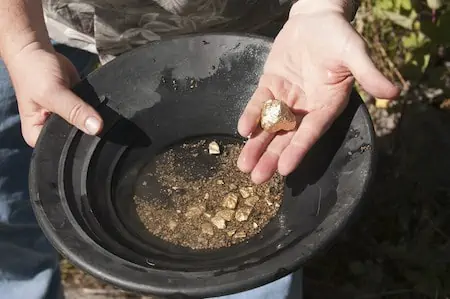
So, look for places with exposed bedrock, either on land or in streambeds. Check areas with exposed tree roots, edges of streams, rivers, and dry washes. Smaller tributaries in high elevation areas are also known to contain some gold in the certain areas.
Types of Metal Detectors
There are 2 major types of metal detectors for hobby metal detecting: Very Low Frequency, or VLF, and Pulse Induction, or PI. A VLF metal detector has a transmitter coil and a receiver coil. These work in conjunction to find targets and relay the information back to the metal detector’s control box. The transmitter coil creates an electromagnetic field and each time the current changes direction the polarity of the field changes.
As the magnetic field enters the ground, it interacts with objects that are conductive. As the coil sends a signal down to the object, the object reflects the signal back to the detector. The number of times the current changes directions within the ground is the frequency at which the metal detector operates. If a detector operates at 6 kHz, its current will change direction 6 times per second. If a detector operates at 90 kHz, it will change direction 90 times per second. This has a lot to do with the sensitivity and effectiveness of the machine.
A PI metal detector uses a single coil to transmit and receive. Powerful short bursts of current are sent through the wire and each pulse creates a brief magnetic field. When the pulse ends, the magnetic field reverses polarity and collapses creating a sharp electrical spike. This spike lasts microseconds and causes another current to run through the coil.
This is called a reflected pulse. Another pulse is then sent, and the process repeats continuously. When a PI detector finds a metal target the pulse creates an opposing magnetic field in the object. When the field collapses, the reflected pulse takes longer to disappear. This alerts the detector to the presence of metal in the ground.
Can Metal Detectors Find Gold?
All metal detectors can find gold. They are designed to find all metals. But certain detectors are made to find specific metal types. There are detectors built for coin shooting, relic hunting, underwater detecting, silver, and gold. Many detectors are all-around metal detectors, meaning they can find all metals equally well. Gold specific detectors are designed a little bit different, though.
Metal detectors made specifically to find gold are some of the most popular tools among gold prospectors. Gold metal detectors are just like any other metal detector but have been specifically calibrated to find gold. Metal detectors work by transmitting electromagnetic fields into the ground, then analyzing the return signal.
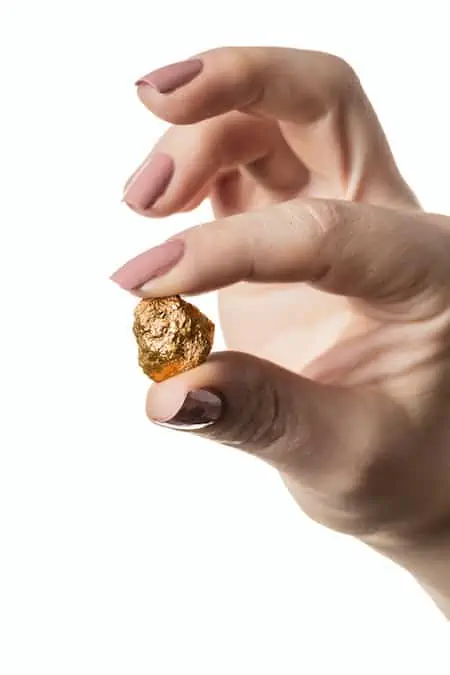
This electromagnetic field induces loops of current called eddy currents, within conductive metals. Eddy currents generate their own magnetic field, which the detector then receives and analyzes. Metal detectors made specifically for gold take this a step further. They measure inductance and conductivity. Inductance is the amount of eddy current produced by a target, and conductivity refers to how easily those currents flow through a target. Gold detectors measure the size of the eddy currents and how quickly they travel, thus, calculating the “time constant” of a target.
A time constant varies among targets. Aluminum, for example, has a short time constant while gold coins or jewelry have a longer time constant. Ferrous metals, like steel and iron, have an even longer time constant. Gold metal detectors are calibrated to specifically search for targets that fall within this middle range. It is not a fool proof system, however, and is dependent upon the size, shape, and depth of a target. But, to compensate, gold detectors can typically be recalibrated in the field to search for a broader or narrower time constant.
Best Gold Metal Detector
Most major manufacturers of metal detectors offer gold specific metal detectors. These detectors can range in price from around $100 to well over $1,000. It really depends on your knowledge level pertaining to metal detecting, your preferences, and your budget. Bounty Hunter is a well-known manufacturer of metal detectors. Their models are typically less expensive than other manufacturers but are more tailored to beginning detectorists. These models are generally simple to use and can give users a good overview of metal detecting.
Bounty Hunter makes a model for gold called the Bounty Hunter Gold Digger. This inexpensive model operates at the lowest frequency on this list, at just 6.7 kHz. This is not an ideal range for finding gold, but it if the nuggets are large enough, it will still find them. This is a good option for anyone on a budget or hesitant to spend a lot on a more upgraded model. I would recommend a higher-grade model for those serious about prospecting, though.
Fisher Labs makes a great model called the Fisher Gold Bug Pro. This model is a mid-priced, VLF detector that operates at 19 kHz. This is a good frequency to find gold. The Gold Bug Pro features many advanced technologies and continuous ground readout to show soil mineralization. This can be helpful as gold is typically found in areas with high soil mineralization and hot rocks. These can throw a detector off quite a bit, and the Gold Bug does a great job of compensating.
Some metal detectors can search at multiple frequencies simultaneously. The Minelab Vanquish series and Minelab Equinox series are both good examples of this. Both metal detector series are multiple frequency models, whose frequencies range from 5 kHz to 40 kHz. This means they are wonderful at finding all metal types. They can easily find gold with their higher frequencies.
The Equinox series features a specific gold mode, while the Vanquish series does not. But it can still be calibrated to find gold. The Vanquish line is tailored more toward beginning detectorists and the Equinox line is tailored more for intermediate or advanced detectorists. The Equinox series is waterproof up to 10 feet, while the Vanquish line comes with waterproof search coils only. The Vanquish line is less expensive, too, and is a fantastic option for anyone looking to enter the world of gold prospecting.
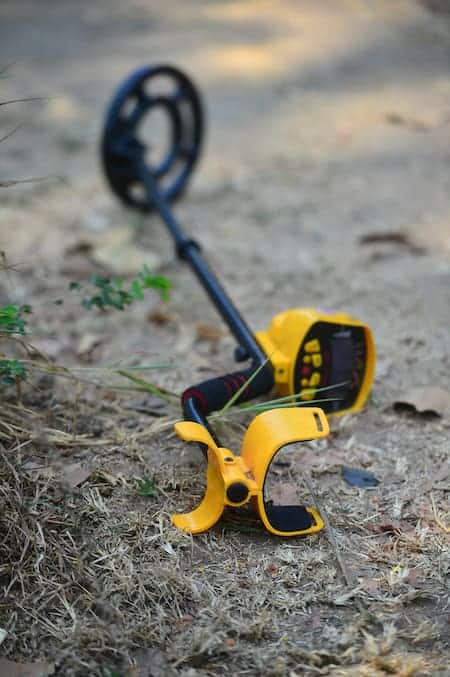
Garrett makes a gold specific model called the Garrett AT Gold. This detector is part of their well-known AT line, but is specifically tailored to finding gold. This model operates at 18 kHz and is fully submersible. This is a great feature for finding gold in rivers and streams. The AT Gold can easily and quickly be ground balanced to filter out noise from soils and electromagnetic interference.
White’s makes a great gold detecting model called the White’s Goldmaster GMT. This detector can easily ignore harsh ground conditions and was designed to find gold nuggets of all sizes. This detector operates at a higher frequency than the others listed so far, at 48 kHz. Because gold and iron can ring up around the same, the Goldmaster GMT features an iron target analyzer that makes separating gold and iron targets much easier. White’s was recently purchased by Garrett, so availability and warranty of this model is currently unknown.
Now. For the best VLF gold metal detector. This honor goes to the Fisher Gold Bug 2. This beast of a detector operates at a whopping 71 kHz, meaning it will be able to find even the smallest gold nuggets. Some detector struggle to find exceedingly small gold or fine gold jewelry. But not the Gold Bug 2. This model features excellent discrimination and can reject iron and hot rocks, making gold prospecting more productive. It also has increased signal boost which increases the sounds from weak or distant signals.
The best PI metal detector is the Garrett ATX. This PI machine emits 730 pulses per second and is fully submersible. It has excellent sensitivity and can find even the smallest gold nuggets. PI detectors are inherently immune to the effects of saltwater, so this detector is great for beach hunting. The ATX features continuous ground track, 2 search modes, 2 detection modes, adjustable sensitivity, and an LED target ID indicator. Overall, this is my top pick for PI metal detectors in general but is also my top pick for PI detectors to find gold.
Search Coils for Gold Detecting
It is important to choose the right search coil for gold prospecting, and to understand the difference among search coils. There are 4 main types of search coils for metal detectors: Mono Coils, Double-D Coils, Concentric Coils, and Smart Coils. Mono Coils are typically used with PI metal detectors.
These are the deepest searching coils but can be more difficult to ground balance in areas with high soil mineralization. A Double-D search coil has the shape of 2 capital Ds back-to-back. This type of coil provides good stability, great ground balancing, and good depth. Areas with high soil mineralization of electromagnetic interference area easily searched with a Double-D search coil. Concentric search coils produce a cone shaped search pattern and require more sweep overlap.
However, they produce the more accurate pinpointing of any search coil. The newest type of search coil is the Smart Coil. Smart Coils contain advanced circuitry like signal boosting, increased depth, immunity to electromagnetic interference, and faster target response. They also have increased sensitivity to small and deep targets.
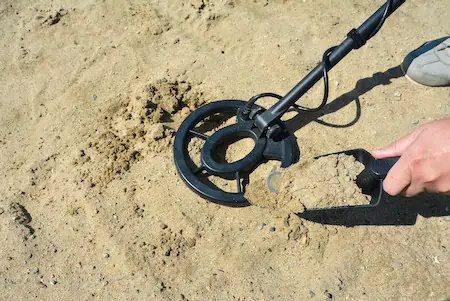
Size is also important for search coils. The size is a major factor in what determines detection depth and sensitivity. Larger search coils will typically search deeper and can cover more ground quickly. Large search coils, however, are less sensitive to small targets and are more susceptible to the effects of electromagnetic interference. Most metal detectors have adjustments to compensate for some of these effects when using a large coil. Smaller search coils have a greater sensitivity to small and shallow targets. These coils are much less susceptible to electromagnetic interference.
While all metal detectors will come with a search coil, detectorists can also purchase different search coils for some detectors. Not all detectors have the option to switch coils. Some come hardwired. But many detectors will have this option. This can help turn a general metal detector into a gold detector.
Metal Detecting for Gold Nuggets
The odds of finding a large gold nugget in most areas are slim. But never impossible! It is important to always look for gold where it has already been found. The most expensive metal detector in the world cannot magically find gold where it does not exist. Some tips for finding gold nuggets with your metal detector are looking in washes, tailings piles, dredge piles, and creeks.
Dry washes, especially here in the west, are great places for gold nuggets to hang out. They are moved by flash floods, so they can be anywhere the dry washes are. Tailings and dredge piles are the leftovers from previous gold searches. These searchers were looking for large nuggets, but many get left behind because they are stuck to some other rock or were too small to bother with.
Creeks are another great place to find gold nuggets. This gold is referred to as placer gold. Gold is a heavy metal. In fact, it is approximately 6 times heavier than the average materials found in streambeds. And this makes its movements within water quite predictable. Gold will continue downstream until it reaches an obstruction.
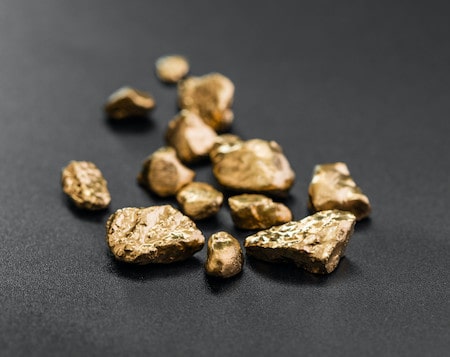
This could be a crevice in the bedrock, a low energy pool, under waterfalls, or anywhere else where the water has lost some energy. Inside bends of creeks and rivers are great places for gold to get caught up. Walk the area and determine where these bends are located. Look for any large boulders within the water that would cause the gold to be stopped. Check areas where bedrock is visible, or shallow. Check for black sands as black sands can be a good indicator that gold is nearby.
Be aware that if you plan to search for gold nuggets in or near water, ensure that at least your search coil is waterproof. I prefer to have a fully submersible metal detector when near water in case it falls in the water. Many detectors are weatherproof but are not waterproof. Those should never be fully submerged, or it can ruin the machine. I usually take my Nokta Makro Simplex+ when detecting near water. This is a VLF detector that is fully waterproof. It is not the best frequency for finding gold, but it does a heck of a job finding most metal targets.
Where To Go Metal Detecting
When we think of finding gold, many of us instantly think of the Gold Rush and the western United States (California and Alaska, most notably). However, the Eastern United States has many opportunities for finding gold, also. Ground mineralization is the major difference between the 2 portions of the country.
The western United States is considered hotter (in terms of both temperature and ground mineralization), which means there are more hot rocks and overall mineralization. There is a good-sized Gold Belt that runs from the northeastern United States through Alabama, and glacial gold can be found in the eastern United States.
The top 8 places to find gold in the United States are:
- American River, California
- Fairbanks, Alaska
- Black Hills, South Dakota
- Northern Nevada
- Pike’s Peak, Colorado
- Rouge River, Oregon
- Dahlonega, Georgia
- Feather River, California
Does this mean these are the only places to find gold in the country? Absolutely not! Major amounts of gold have been found in:
- Colorado
- Georgia
- Idaho
- Michigan
- Montana
- Nevada
- New Mexico
- North Carolina
- Oregon
- South Carolina
- South Dakota
- Tennessee
- Utah
- Virginia
- Washington
- Wisconsin
- Wyoming
Do not worry if your state is not on this list. These states are known for larger scale gold production. If your area does not have a rich gold history, you may still be able to find gold jewelry and artifacts.
One thing to note: if you will be prospecting in the desert, keep an eye out for rain. Flash floods can happen very quickly once the weather moves in and they can be brutal! I got caught in flash floods in Las Vegas several times when we lived there, and they are no joke! Out in the open desert, the water can come in very quickly, so always be aware! After it rains is a great time to search for gold, though. Water is a great mover of earth, so check after the rains have dissipated in the desert and you may find newly uncovered gold!
Gold Prospecting Laws
As with any type of metal detecting, it is of the utmost importance to follow all laws. These laws are federal, state, city, and county, and must be followed. Failure to do so can result in hefty fines and confiscation of property. You may even face jail time. There are federal laws pertaining to treasure hunting, prospecting, historic or prehistoric item searches, and recreational metal detecting.
You must also know where you can legally metal detect. For example, you may metal detect on public lands and national forests, so long as no historically important areas are designated. You may never metal detect within a national park, state park, national monument, Native American reservation, or private property without exclusive permission. Any historically important find should immediately be reported to your local and state authorities.
Prospecting using a metal detector, or finding any mineral deposit, it allowed under the General Mining Laws. A notice of intent is not typically required unless the search will cause significant soil disturbance or natural resource disturbance. A plan of operation is required for prospecting that will cause significant disturbances. It is also important to note that many areas on public lands and within national forest boundaries where known ores have been found are previously claimed.
It is again, of the utmost importance to find out whether these claims are valid. I lived in southwestern Idaho for man years, and many of the creeks in the area known for placer gold had current mining claims on them. Claim jumping is a serious offense and can result in fines or imprisonment.
I always recommend a thorough search of your intended area prior to going out. I do not take any metal detecting equipment at all until I know for sure the area is unclaimed. Just being on someone’s claim with prospecting equipment can be seen as intent to prospect and can result in charges against you. Remember: claiming you did not know a rule or law does not always work. Do your research and protect yourself!
Items to Take with You
While a metal detector and shovel are all you really need to metal detect anything, there are a few items that make your searches easier. If I know I will be hunting near a creek or stream, or shallow river, I always take gold panning equipment with me. I take at least one pan, a snifter, and a scoop. These are all lightweight and easily carried in a backpack.
This way, I can sample areas for gold before getting out there and soaking myself. I also like to have a good quality pinpointer. These are handheld metal detectors that make narrowing down your search area a lot easier. You will dig less and be able to search more. Also, make sure you have the proper digging equipment.
I prefer to take a short, handled shovel and a hand digger. It is important to get high quality equipment. You do not want your shovel or hand digger breaking when you are on the trail of a target. Talk about frustrating!
When prospecting, I also like to take map. An old school, paper map. I do this for the reason of marking claims. You can check online to see if an area has an active claim, or you can look when you arrive at your destination. These claims must be marked properly. This way, I can pinpoint where I am on the map and where any claims are.
A finds pouch is important for most metals, but for gold nuggets, unless they are massive, you will want a smaller bottle to hold them in. Often, I find only flakes or flower gold, and these are much too small to toss into a finds pouch.
Other items to bring along are simple things we typically take anyway: sunscreen, bug spray, snacks, plenty of water, and your phone (for mapping and calling for help, if necessary). I take a decent sized backpack to carry all my gear and keep it organized.
Conclusion
So, do metal detectors detect gold treasure and fortune? Yes. Yes, they do! You do not need a wildly expensive metal detector to find gold, but if your budget allows, and you have the necessary metal detecting skills, I recommend a mid-priced to high-end gold detector.
The guesswork has been taken out of these detectors and they are already specifically calibrated to find gold. Especially if you are in an area known for producing gold. There are many such areas in our country and many of them are on public lands or national forest lands, which we can access any time, weather permitting.
FAQ
Q: Is it worth buying a gold specific metal detector if I want to search for all metals?
A: If you plan to search for gold but want a metal detector that will easily and efficiently find all metal types, a gold specific metal detector can do this. If you purchase a metal detector with removable search coil, you can change the coil, and thus the frequency, to anything you want. Any metal detector will find gold. They will find all metal targets. Gold specific metal detectors are simply better calibrated to differentiate between gold and iron targets. Both tend to alert a metal detector similarly, so these machines are better at showing gold rather than junk targets.
So short answer, you do not necessarily have to buy a gold specific detector, but for prospecting, it is highly recommended.
Q: I do not live in an area known for producing gold. Should I even bother searching?
A: While you may not live close to a gold ore producing location, you can always take your gold metal detector, or general all-purpose metal detector, to local area beaches and recreation areas. These are where people tend to lose a lot of items including coins and jewelry. Many states in the country are known for producing gold ore. Try taking a vacation to one if you are able. Take along your detector and see if you can find a nugget or 2!
Q: Is it really a big deal to jump a claim? What if no one sees me?
A: Even if no one is around, it is a huge deal to claim jump! With the number of trail cameras around now, I would not even recommend chancing it. These cameras are designed to work for extended periods of time (mine works for up to 6 months on a single set of batteries). While you may not get caught the day you work someone else’s claim, you are running the risk of being caught later.
It also can give the rest of us a bad name if metal detectorists are constantly jumping other people’s claims. We all must try to put our best foot forward for the hobby. The way I look at it is even if the area I wanted to search is claimed, I would bet the areas nearby, that are unclaimed, have some gold, too. Search these areas instead and keep within the law.
Q: If large gold nuggets are rare, is it even worth searching for small nuggets or flakes?
A: In my humble opinion: YES! If you have never experienced that beautiful glint staring at you through the crystal-clear water of a stream, I promise you, you will be hooked! You may not find the Hand of Faith (the giant gold chunk at The Golden Nugget in Las Vegas), but enough small gold really does add up. Remember: the old-time gold hunters were looking for large chunks of gold. They had little to no interest in smaller gold. There is plenty of gold out there still to find. We just must go looking for it!
If you enjoyed this article, please “like” our Facebook page and be sure to revisit Discover Detecting for new content surrounding the metal detecting hobby!
You Might Also Want to Read: